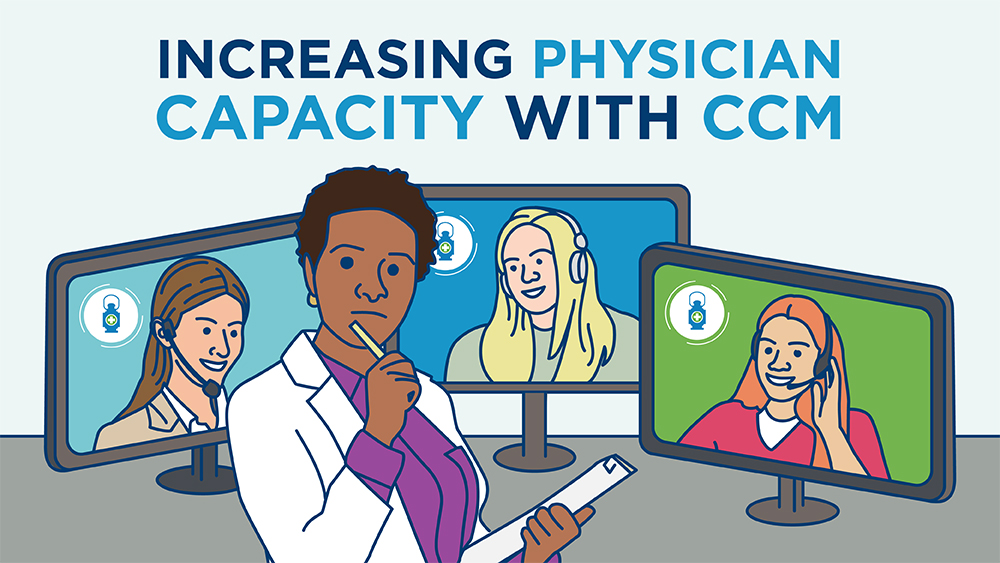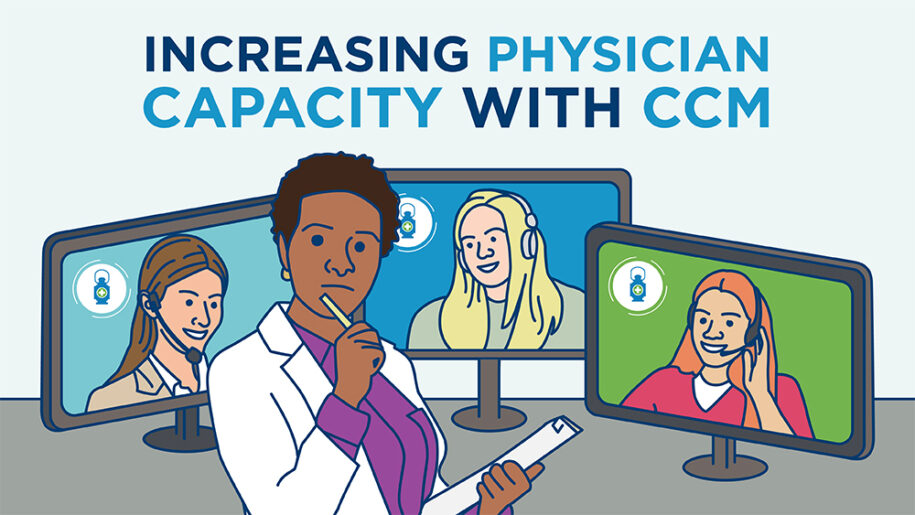
Increasing Physician Capacity With CCM
In July of 2022, Justin Porter, Assistant Professor of Medicine at the University of Chicago Medicine and a team of other researchers published a study in the Journal of General Internal Medicine titled: “Revisiting the Time Needed to Provide Adult Primary Care” [1].
Their main takeaway was that primary care physicians would require 26.7 hours per day to satisfy recommended care guidelines, with 14.1 h/day for preventive care, 7.2 h/day for chronic disease care, 2.2 h/day for acute care, and 3.2 h/day for documentation and inbox management.
In other words, modern primary care physicians are being stretched beyond their limits. Even in a vacuum, there simply aren’t enough hours in a day to cover all of the stipulations for “ideal patient care,” especially for chronic disease patients.
How can we expand physician capacity to adequately meet the needs of chronic disease patients, without increasing the physician’s burden of care?
Longitudinal engagement of patients in between office visits with remote chronic care management (CCM) services is the solution. But despite Medicare reimbursements being available for CCM since 2015, few provider organizations are delivering these services to more than 2% of their eligible patients, if any at all.
What Is Chronic Care Management?
According to the CMS, more than 117,000,000 adults have at least one chronic health condition, with 25% of adults having two or more [2]. These ongoing conditions can have deleterious effects on a person’s quality of life, impacting their physical, mental, and economic well-being. Common chronic conditions may include:
- Diabetes
- Heart disease
- Hypertension (high blood pressure)
- Chronic obstructive pulmonary disease (COPD)
- Asthma
- Arthritis
- Cancer
- Depression
- Anxiety disorders
- Chronic kidney disease
- Alzheimer’s disease and other forms of dementia
Each of these issues must be monitored and treated on a regular basis. And, as Porter’s study illustrated, such tasks can’t be solely treated in an outpatient setting, especially by primary care physicians who are already stretched thin as is. Instead, it takes a village.
CCM programs bridge the care gap via a proactive and coordinated approach to managing chronic conditions outside of a hospital setting. This helps to alleviate the burden that would otherwise be placed on a primary care physician who likely lacks the necessary time or resources to adequately provide these essential services.
How Does CCM Work?
A CCM program can function as an extension of the existing primary care team, helping to increase access to care, improve outcomes, and foster longitudinal patient engagement.
Much of the preventative care typically expected of a primary care practice can instead be delegated to other healthcare professionals, such as registered nurses. Outsourcing these assignments allows doctors to focus on the more complex and value-add aspects of patient care provision.
A CCM nurse can perform a number of preventive and chronic care-related tasks, including:
- Medication Reconciliation – Nurses can review patient medication lists, checking that they’re accurate and up-to-date in order to reduce medication errors and ensure that patients take the best medication at the right time in the proper dosage.
- Depression screening – Nurses can check up on patients and perform mental health screenings to ensure that mental health issues don’t exacerbate physical health outcomes.
- Fall risk screening – Seeing as trips and falls are the leading cause of unintentional injuries among senior adults, which could then exacerbate a chronic condition, care nurses can monitor patients and identify behaviors or signs that might put the patient at risk of a fall [3].
- Referral management – Nurses can coordinate referrals with other healthcare professionals or providers, including specialists or therapists to ensure patients receive proper care.
- Transition of care – Nurses can assist patients with transitional care (TCM) from one healthcare setting to another, such as from a hospital to their homes, helping to ensure they understand their discharge care plan, fill prescribed medications and schedule follow-up visits with their primary care physicians.
- Patient education – For the best health outcomes possible, patients need to understand their conditions, medications, and treatment plans. Nurses can provide ongoing education and support that empowers patients to be active participants in their chronic care management.
- Scheduling – Nurses can schedule regular and annual wellness visits (AWVs) to ensure patients receive their necessary preventative care and screening.
- Remote patient monitoring – With the help of IoT health technologies, nurses can perform remote patient monitoring (RPM), which makes it possible to identify behavioral or vital sign changes that might signal an impending health issue. The nurses then follow up and triage patients who are out of bounds (based on predetermined clinical parameters), only involving physicians when medical decision-making is required.
Benefits of CCM
CCM benefits both patients and providers.
Improved care coordination can make a tangible impact on health outcomes. Better medication management and patient engagement reduce hospitalizations and free up primary care physicians to focus on more complex health issues that actually require medical decision-making.
A high-quality CCM program will enhance patient convenience and access to care, especially for those individuals living in rural or underserved areas. And, ultimately, it will reduce overall healthcare costs by addressing and treating potential health issues early on.
CCM with Signallamp Health
Today, doctors lack the capacity to handle the myriad tasks associated with chronic health issues. And, for such conditions, patients need additional support that extends far beyond the walls of a traditional office setting of a primary care practice.
To ease the burden on doctors and improve patient outcomes, the industry must shift to scalable models like CCM & RPM, which are sustainable long term through existing reimbursements. This is where Signallamp can help.
The Signallamp Health CCM and RPM services platform enables you to offer these services to your patients at scale, staffed with dedicated nurse care teams (no call centers), documenting directly in your EMR, all funded through existing reimbursements (literally zero out-of-pocket expense).
Schedule your CCM consultation today to find out how we can help you expand physician capacity and increase primary care touchpoints with your chronic disease patients, without increasing the burden of care upon your existing providers.
Sources
[1] Springer.com Revisiting the Time Needed to Provide Adult Primary Care. https://link.springer.com/article/10.1007/s11606-022-07707-x
[2] CMS. Chronic Care Management. https://www.cms.gov/about-cms/agency-information/omh/health-equity-programs/c2c/ccm
[3] PubMed. Slipping and tripping: fall injuries in adults associated with rugs and carpets. https://www.ncbi.nlm.nih.gov/pmc/articles/PMC3591732/

